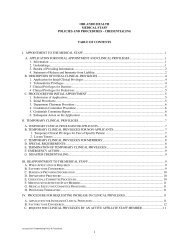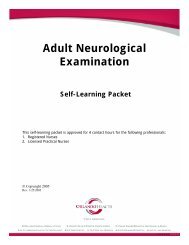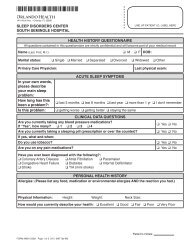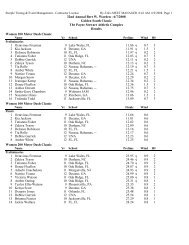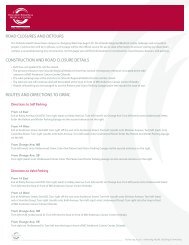Advanced Hemodynamics - Orlando Health
Advanced Hemodynamics - Orlando Health
Advanced Hemodynamics - Orlando Health
Create successful ePaper yourself
Turn your PDF publications into a flip-book with our unique Google optimized e-Paper software.
<strong>Advanced</strong> Hemodynamic Monitoring<br />
Secondary Assessment:<br />
Problem/assessment Cause [reason] Intervention / action needed<br />
Overdamped waveform<br />
Air, blood, clots, in the tubing<br />
Tubing is too long, kinked,<br />
connections are loose<br />
Remove air, blood, clots<br />
Remove tubing extensions, replace<br />
kinked tubing, tighten connections<br />
New transducer<br />
Underdamped waveform Air bubbles Remove air bubbles from the<br />
system<br />
New transducer<br />
Deflated balloon becomes<br />
wedged—Requires urgent<br />
intervention<br />
Overwedged—<br />
Requires urgent intervention<br />
Ventricular irritability—<br />
Requires urgent intervention<br />
(premature ventricular<br />
contractions, ventricular<br />
tachycardia or fibrillation)<br />
<br />
Seen on insertion as<br />
well as during ongoing<br />
use<br />
Coil of catheter straightens as the<br />
catheter warms in body causing the<br />
catheter to “lengthen”, progressing<br />
further into the pulmonary system<br />
Balloon over-inflated<br />
Catheter stimulates the myocardium<br />
Catheter needs to be pulled back<br />
(out) until un-wedged, re-secured<br />
and new measurement markings<br />
seen on catheter for reference and<br />
new waveform documented<br />
On-going monitoring to assure that<br />
waveforms are indicative of<br />
appropriate catheter position<br />
Deflate balloon. Catheter should be<br />
repositioned if necessary (check<br />
waveform prior to initiation of<br />
occlusion procedure), then reinflate<br />
balloon with only enough air<br />
to produce PAOP waveform pattern<br />
on monitor<br />
On-going monitoring to assure that<br />
waveforms are indicative of<br />
appropriate catheter position<br />
Repositioning of catheter<br />
Suturing to maintain positioning<br />
On-going monitoring to assure that<br />
waveforms are indicative of<br />
appropriate catheter position<br />
PA balloon rupture—<br />
Requires urgent intervention.<br />
If suspected, further attempts<br />
should not occur in order to<br />
prevent further air embolism<br />
<br />
No sensation of<br />
resistance on<br />
Causes of balloon damage:<br />
Over-inflation of balloon<br />
Frequent inflations<br />
Using the syringe to deflate<br />
the balloon<br />
Cap balloon port after having<br />
removed the syringe and clearly<br />
labeling the port so that other<br />
clinicians will no longer utilize the<br />
port<br />
Copyright 2010 <strong>Orlando</strong> <strong>Health</strong>, Education & Development 16




